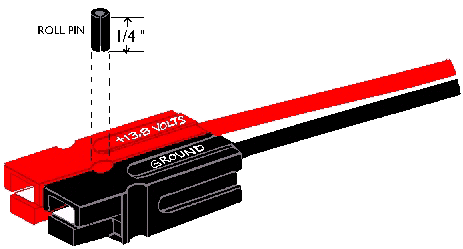
Matt Meola
ex KCØDXW
 |
Matt Meola ex KCØDXW |
ARES Standard Power Cable
Power is always an issue in Amateur Radio; if you haven't come across some kind of an issue with the acquisition of reliable DC, then you probably will, sometime in the future. Perhaps the most common radio used in the public service arena is the HT, and for good reason. They are lightweight, easy to use, and allow the ham to walk around and maintain communications. Their downfall, among other things, is the battery pack - it is often much smaller, capacity-wise, than what is needed for an extended response. My most important experience with power, so far, was when the Hi Meadow Fire broke out. I was on the bus, with just my HT's battery, and it was weak. Had it not been for another ham who showed up with an MFJ power center, I would have been toast. However, having power available and being able to make use of it can be two very different things. The ARRL has defined a standard power connector as the Molex 1545 series two-pin connector. The positive pin is the one toward the "top" - the peaked part of the housing. The "shell" gets the male pins, and must be wired to any device you wish to power. In other words, the hollow shell, with the pins (as opposed to the sockets), receives power; the solid shell, with the female pins, provides power. This connector is rated at 2A, 250V. While the voltage is nice, the current rating is rather low. Moreover, the rated number of connect-disconnect cycles is very low - on the order of a dozen or so. There has been much discussion about a new standard connector, and the Colorado section has endorsed the use of Anderson Powerpole connectors. They are genderless, come in many different amperage ratings, most notably 15A, 30A and 45A. Those three sizes all share the same housing; the contact size differs as to what size wire it can accept. Powerpole connectors are designed to handle hundreds of connect-disconnect cycles. Thus, they are a nice replacement for the venerable Molex connector. 
The default configuration, from the PowerWerx web site There are a number of places where they can be purchased; first and foremost, perhaps, is PowerWerx. They also sell red/black zip cord, in various sizes. Cable X-perts also sells them, but they don't have quite the selection that PowerWerx has. On the other hand, Cable X-perts is cheaper on their zip cord. Moreover, All Electronics has red/black zip cord in smaller sizes, and their prices are pretty good, too. I have chosen to go with the Powerpole connectors, for a number of reasons. My first attempt was overly complex, but it made for a good power cable. My second is much simpler. All of my machinations in this area were inspired by the good people who support the Baker to Vegas road race; their website is here. They use APRS to keep track of vehicles, and with trying to place some two dozen different trackers into service, one can see why a standard power connection was necessary. Moreover, the rigors of connecting and disconnecting those power cords many times just in the course of a race, let alone from year to year, ruled out the Molex connectors, since those are only rated for a dozen or so connect-disconnect cycles. The powerpoles are designed for very many more. The baker-to-vegas power cable pages are here; their APRS trackers' setup can be found here. There's some pretty good info in those pages. The topology of one of these harnesses is typically a main trunk with smaller branches for the various pieces of equipment. A trunk made from 12 AWG wire can handle as much as 25A over 100 feet (33m) with no voltage drop; however, putting a big rig, like my Icom 746 on that thing will consume 20A of that capacity, leaving precious little for anything else. For one of those, 10 AWG is a better choice. The branches are generally short, about a foot (31cm) or so, and are made from either 16 AWG or 18 AWG wire. My two attempts used 16 AWG, since PowerWerx, at the time that I ordered it, didn't have 18 AWG; now they do. The wire can be anything one desires, but the best, overall, is red/black zip cord. It is an automotive power cable that comes in various sizes; fairly flexible and durable. This one was designed to use fewer components, and yet be as flexible as I needed it. I estimated that five "outlets" on the cable: one on the 12 AWG main trunk for a mobile or a portable unit -- a high-current draw rig; one for an HT; one for a GPS or another thingy; one for a TNC; and one for a cigarette lighter socket, from which one can run small inverters, for a laptop. That means I have a 30A connection on the end of the trunk, and four branches terminated in 15A connectors. |